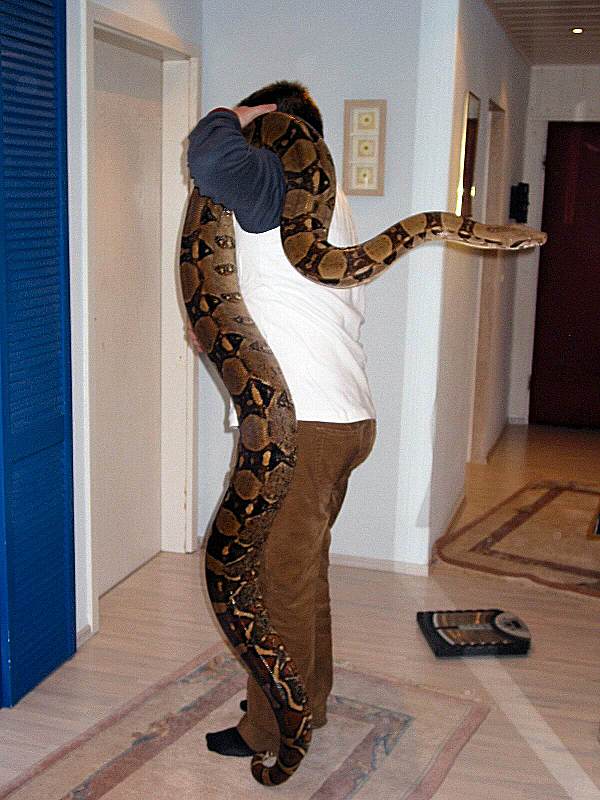Since this topic is frequently discussed and there is a great amount of confusion regarding the potential size of Boa constrictors, we decided to dedicate a separate page to this topic.
Horror stories about boas of 14 ft in length (or even more) are often scaring people who are considering the purchase of a Boa constrictor.
First off, we have yet to see a boa of such a length. Even if such an animal actually does exist, it would surely be an exceptional case, sort of like a 7 ft tall top score basketball player in the first league.
Unfortunately, many authors of books about boas stick to such record dimensions and mislead the people with these. For instance: It would not make any sense to write a book about the anatomy of human beings in which a height of 7 ft is given for Homo sapiens. However, this is exactly what happens in these books. Most of the authors provide the record length, thereby creating the impression in the reader that this is actually the average size.
On top of that, record-size data tends to be very unreliable:
For a long time, redtails from Trinidad were thought to be the largest of all Boa c. constrictor. This widespread belief originated from false information published in "Snakes in Fact and Fiction" by James Oliver in 1963.
He wrote that he record for this species was 18'6", obtained from an individual specimen that was killed and measured in Trinidad by Colin F. Pittendrigh while he was on the island conducting malaria-work during World War II.
However, it turned out that this 18.5 ft record was a misidentified anaconda, according to a report in Herpetological Review.
OK, what size do they actually reach?
In our experience, even those subspecies of Boa constrictor that are considered to have a significant growth potential rarely reach 10 ft in length.
The largest Boa constrictors are Boa c. constrictor from Peru and Boa c. imperator from Colombia. We would declare the average size of sexually mature females to be 8 ft. (if a reasonable feeding schedule has been applied).
 This female is probably the largest Boa constrictor kept in captivity in Germany. She was born in 1997 and is weighing 30 kg (60 pound). The ancestors were from Colombia. Such a size can only be achieved by feeding guinea pigs and rabbits.
This female is probably the largest Boa constrictor kept in captivity in Germany. She was born in 1997 and is weighing 30 kg (60 pound). The ancestors were from Colombia. Such a size can only be achieved by feeding guinea pigs and rabbits.
photo: Stefan Strebl
To the best of our knowledge, the smallest of all Boa constrictor subspecies are the Boa c. imperator from Tarahumara/Mexico, the Cay Caulker Boas and the Ambergris Caye Boas.
Boa constrictor length | Boa c. constrictor size | size of Boa c. constrictor | maximal size of Boa c. constrictor | size of Boa c. imperator | Boa c. imperator length | maximum size of Boa c. imperator | size of Boa c. amarali | Boa c. amarali length | maximum size of Boa c. amarali | size of Boa c. sabogae | Boa c. sabogae length | maximum size of Boa c. sabogae
In the past, we made the experience that boas which had been considered to be a dwarfish form would eventually turn out to reach an average size when a reasonable feeding schedule was applied.
However, this does not apply to the variants mentioned before! They stayed very small, despite being well-fed. None of them significantly exceed 4 ft. (120cm) in length.
One of the most valuable pieces of information on this issue is the fact that the keeper of a Boa constrictor has excellent means of directing the size of his/her boa according to his/her desire.
The key factor for this is the feeding schedule:
Please take note that adult rabbits or guinea pigs are no suitable boa food! While they may overcome such a large prey item, it is an exertion for the digestive tract and a blow for the system. Fatty liver is frequently diagnosed in animals where such feedings have been applied.
The second side effect of such enormous prey items is the growth boost in the boas. If you stick to rats, baby rabbits or baby guinea pigs, the growth rate of your boa will always be within a reasonable range.
The most significant growth of a boa takes place within its first 4 years of life. If you restrain the snake from feeding too much during this time, you will avoid the risk of getting a boa that you may consider to be too large for keeping it until its demise.
Conservative Feeding
And last but not least, the best news: Every somewhat experienced boa keeper is able to apply a feeding schedule that prevents any further significant growth in adult boas.
This means that when your adult boa has reached 6 ft in length and weighs 9 pounds (just an example), you can feed it in a way that the animal will more or less remain at this size and weight. This does not harm the animal at all. To the contrary, such animals will be more healthy and fertile than those fat truck tires that are frequently found in the terrariums of breeders who think that feeding an adult rabbit every two weeks is necessary to be successful in breeding boas.
In conclusion we would like to add some lines about the alleged 49 feet reticulated python that has been a top theme in the Medias at the end of last year. It’s a telling illustration how the length of boids is exaggerated by the people.
The text is an abstract from Reuters, published Jan 7, 2004:
When a recreation park in Indonesia put a huge reticulated python on show last week, keepers insisted to reporters it was 49 feet long. That made it the longest ever caught.
But amid growing scepticism of the claim, a photographer working for Reuters returned to the Curugsewu park in the small central Java town of Kendal Wednesday with a measuring tape.
The snake's true length -- around 21 feet
"I have no idea why the snake has shrunk," said one keeper when asked about the discrepancy, as the snake lounged on a tree branch inside its cage.
According to the Guinness World Records, the longest discovered snake was also a reticulated python from Indonesia. It was 33 feet long when found in Sulawesi island in 1912.
In 2002, Samantha, a 25-foot snake which was dubbed the largest in captivity, died in the Bronx Zoo in New York. Samantha came from Indonesia's side of Borneo island.
Record-breaking or not, word of the huge snake in Kendal has spread, tripling the number of visitors to the state-run park, normally known just for its scenery and waterfalls.
